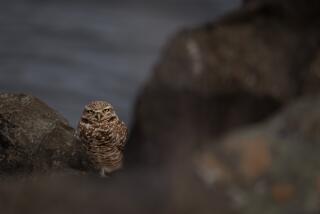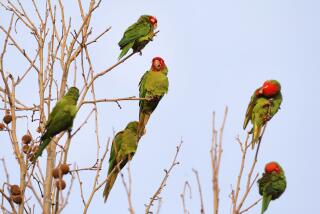Is This Bye, Bye Birdies?
The stars of the show are likely to be absent today when the return of the swallows festivities get underway. But that won’t keep thousands of tourists and locals alike from flocking to Mission San Juan Capistrano to take part in the quaint tradition that put this community on the map.
Efforts to lure the swallows back with everything from their favorite snack--ladybugs--to manufactured mud nests have met with only marginal success: The number of swallows migrating back to the mission continues to dwindle.
It’s not something that city officials, local residents and mission leaders wish to dwell on in a city that even has a Swallows Cleaners. But this year, they are trying to strike a better balance between highlighting the swallows’ return and other local events.
“There’s more to this wonderful city than birds,” said Mission San Juan Capistrano administrator Gerald Miller.
The swallows’ image will be prominently displayed this weekend for the thousands of expectant tourists. There will also be food concessions, music, arts and crafts and parades--and, of course, the mission, Miller said.
Even if the guests of honor don’t pack the house, the Swallows Day festivities are joyous and entertaining, he said.
Bird expert Sylvia Gallagher, who has noted the diminishing number of swallows at the mission, compares the weekend’s activities to Christmas celebrations.
“Some people just like to go to the festival ‘cause it’s fun. It’s like Santa Claus,” Gallagher said. “You may be aware there’s no Santa Claus, but you enjoy the festivities that surround the myth.”
Miller insists that tourism in this bucolic city of Spanish architecture and historic streets does not rise and fall on the birds’ return.
In his eight years as Mission San Juan Capistrano administrator, Miller has become a tireless researcher of the city’s history. The result has been a number of new festivals and other events at the mission.
The city also boasts some of the oldest adobe homes in the country.
Still, the Swallows Festival, which on March 25 includes one of the country’s largest non-motorized parades, draws more visitors--especially international tourists--than the other local festivals, Miller said.
Legend has long had it that the swallows return at this time every year and take up residence in their mud nests. As recently as 1997, swallows regularly returned to the mission from Goya, Argentina, as they’ve done for hundreds of years.
But construction at a local landmark has brought the dwindling number of birds into sharp focus. Repair work being done at the old Great Stone Church--once the lofty mecca of swallowdom in this city of 31,000--has spooked the birds away, city officials say. Years of urbanization have also sapped their numbers.
“Most birders snicker at the whole story. There isn’t one who isn’t aware that it’s kind of a fraud--that there’s almost no swallows in Capistrano anymore,” said Gallagher, an expert for the Sea and Sage Audubon in Irvine and author of the “Atlas of Breeding Birds in Orange County, California.”
The city hasn’t given up trying, though.
In addition to ladybugs and fake nests, the city is avoiding development in certain areas that have been favored by the swallows, like the open space near Trabuco Creek.
But the reality is that as the South County becomes more developed, the swallows will go elsewhere, said Councilman David Swerdling.
And while in headier days the draw was the sight of a relatively large group of the swallows showing up in unison, the attraction now may be catching a glimpse of the elusive birds.
The new realities inspire a certain level of showmanship.
Mike Gastelum, 44, will be ringing the bell to signal the “first” swallow spotted. It’s a job he took over from his grandfather, the late Paul Arbiso, who performed the rite for 42 years.
Gastelum said he has been instructed to ignore the first birds he sees and ring the bell after 8 a.m., when more people have gathered on the mission grounds to watch.
“It’s become more commercialized, more of a production,” concedes Gastelum. “My grandfather didn’t have a time schedule to ring the bell--I do. He saw a swallow at 7 a.m., and he was ringing that bell.”
(BEGIN TEXT OF INFOBOX / INFOGRAPHIC)
Searching for Swallows
Everything from ladybugs to fake mud nests have been used to lure the swallows back to Mission San Juan Capistrano--with little success. When the Return of the Swallows Festival gets underway this weekend, its likely the stars of the show will be absent. A closer look at the swallows that have put this Orange County city on the map.
SWALLOW TALE
1776: Mission San Juan Capistrano is founded by Fr. Junipero Serra
According to legend, in the early days of the mission, one of the Spanish Franciscan padres saw an innkeeper destroying swallows’ nests on his building. The priest welcomed the birds to the nearby mission, saying there was “room for all.”
1812: Earthquake destroys Great Stone Church, and swallows nest in its ruins.
1910: Pastor Fr. St. John O’Sullivan notices the swallows return from South America every March 19, the feast of St. Joseph. Local townspeople begin to greet the birds with ringing of the mission bells and festivities.
1936: “Swallow’s Day” is broadcast live on national radio.
1939: Leon Rene sings his hit song, “When the Swallows Come Back to Capistrano,” spreading the legend internationally.
CLIFF SWALLOW (petrochelidon pyrrhonota)
*Cliff swallow is 5-1/2 inches long, similar to a house sparrow. It gulps insects in flight.
*Nest is made of mud and saliva and takes 5-14 days to build; nests are often repaired and reused. Usually clustered under building eaves and under bridges.
*Female lays four or five white, cream or pinkish eggs, sometimes with brown spots.
*Both parents incubate eggs for up to 16 days, and young fly when 24 days old. Pairs can have two broods per year.
Birds fly about 15 hours per day at about 18 mph at altitudes of about 6,600 feet. The swallows depart on their month long journey in mid-February.
Sources: Mission San Juan Capstrano, City of San Juan Capistrano, Sunset’s “The California Missions”
Reporting by PAUL DUGINSKI/Los Angeles Times
More to Read
Sign up for The Wild
We’ll help you find the best places to hike, bike and run, as well as the perfect silent spots for meditation and yoga.
You may occasionally receive promotional content from the Los Angeles Times.







